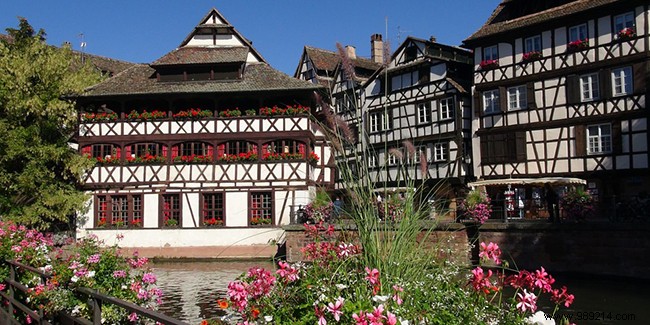
Bordering Switzerland and Germany, Alsace is a historic French region of magnificent beauty. If you want to discover it and see wonderful villages, castles and superb panoramas, travel its roads in a motorhome between Mulhouse and Strasbourg and you will be charmed by its many wonders. To help you better visit Alsace, here are some tips that may be useful and valuable to you on your next trip.
Although we advise you not to take the Alsace motorways in a motorhome, you should know that they are almost all free except for a few sections on the Mulhouse side. It is therefore better to drive on the departmental and secondary roads to take advantage of the magnificent landscape that awaits you.
Some of the Alsatian villages do not allow them to be crossed by motorhome, because traffic is very difficult there. If you are in this case, leave your motorhome outside in a car park and take the opportunity to visit these magical places by bike or on foot. In general, there is also an area or a campsite near your place of visit. Wild camping is prohibited and punishable. Highly monitored by the local police, if you break the law, you immediately face a fine. If you have certain guides or Internet applications, you will find spots where it is allowed to stop for the night.
To discover Alsace, it is best to go there between the months of May and September, although there are quite a few people in July and August. Although it rains enough in May and June, temperatures are already mild and around 20°. In summer, temperatures can rise very quickly during the day, because the climate is continental and it is not uncommon to have days around 40°.
If you have one or two weeks, we advise you to follow the itinerary of the wine route of Alsace and its castles
You can start with Marlenheim which is a very famous wine town. Then head to Wangen by pretty winding roads and if you can, do a tasting of Bruderhal which is a classified grand cru wine with an exceptional and inimitable taste. Proceed to Rosheim and stop to visit the town center and its 12th century church. You can then resume your journey to Obernai and marvel at its half-timbered houses, its belfry, an admirable wheat exchange and the ramparts fortifying this magnificent historic centre.
If your second visit is dedicated to the Haut-Koenigsbourg castle, to get there, you will come across the ruins of many fortified castles on your way that you will see on rocky outcrops. You will admire half-timbered houses dating from the 18th century at the foot of the fortified castles of Ortembourg and Ramstein before arriving at the Château du Haut-Koenigsbourg dominating the plain at an altitude of 800 meters. This castle dates from the 12th century. It is in the town of Orschwiller. After successive destruction and restoration, this castle is today in an exceptional state of conservation. You can admire its bastions, its square keep, its main gate, its upper garden, the dwelling, the half-timbered mill and the fountain, the famous lions gate, the hexagonal staircase, the cistern, the well, the Kaiser's room, the banquet hall, the Lorraine room and many other marvels all with extraordinary history.
On your way to Colmar, you will be able to visit the village of Ribeauvillé with its very colorful houses. Ribeauvillé is one of the most beautiful villages in Alsace. Dominated by three castles, Ribeauvillé with an exceptional heritage is also famous for its Gewurztraminer wines , tokay and pinot gris. On a similar model, you will find the village of Riquewihr with its 16th century half-timbered houses, fountains, ramparts and various cobbled courtyards. A little further on awaits another local marvel called Kaysersberg crossed by the Weiss. Take photos from its fortified bridge over the half-timbered houses and storks if you are lucky enough to see any.
Colmar is nicknamed the “little Venice” of Alsace. The old Krutenau district is crossed by the Lauch river. You will see many market gardeners on boats. This river is surrounded by half-timbered houses full of flowers and terraces of restaurants and cafés where you can stop to taste traditional cuisine or simply cool off. You can also admire the superb Issenheim altarpiece by the painter Matthias Grünewald at the Unterlinden Museum .
The southern Alsace wine route is less frequented by tourists and therefore much less known. She doesn't deserve it though. Visit the medieval village of Eguisheim built around his castle. You can then go and see the great Ballon des Vosges and its eponymous town of Guebwiller, which has four Grands Crus Classés. Further south you will come to Thann which is the town ending the wine route and this route.
Reminder :if you have the right to park in a car park for the night, be careful not to take out your chairs and your table. You are not at a campsite. If you want to settle down for a few days, prefer farm camping or go to a campsite near a place to visit. Enjoy your visit!